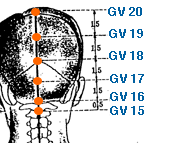GV 15
Acupuncture Point Theory
GV 15 Acupuncture Point Applications and Theory
 The acupuncture point "GV 15" , 啞門, is represented by "Ya Men" in pinyin and "Mute's Gate" in english and may be found:
The acupuncture point "GV 15" , 啞門, is represented by "Ya Men" in pinyin and "Mute's Gate" in english and may be found:
.5 cun above the midpoint of the PHL in a depression below the spinous process of C1.
Of many possible clinical applications, it may be considered to influence the following issues/symptoms:
- Opens the orifices refers to the mouth, throat and tongue, for throat swelling, hoarseness, post-stroke speech disorders, important point for muteness due to tongue stiffness or vocal cord disorders.
- Epilepsy, stroke, manic depression, loss of consciousness.
- Occipital headaches, especially with neck stiffness, upper cervical pain and restricted neck rotation, heaviness of head - GV 15 lies over the space between C1 and C2, and can help release the suboccipital musculature which compresses the atlanto-occipital joint.
- Tong Ren/Tam Healing System: Used to stimulate the medulla and limbic system, useful for emotional issues.
GV 15 has some precautions to be considered (see our precautions list).
Avoid Moxa (MX)
No Deep Needling (NDN)
Gv 15 has the following theoretical associations which serve as important guideposts in designing an effective treatment protocol:
- Window of the Sky Point
- Sea of Qi Point (with CV 17, ST 9, GV 14)
- Intersecting point of the Governing Vessel & Yang Wei Vessels
Explore gv 15 functional grouping theory - Four Seas, or read all point categories and related theory.
While not necessarily valid clinically, EX Huatuojiaji at C2 (C2 innervates the forehead and the frontal lobe. …) and UB 10 (Relieves pain - neck issues, stiffness, ROM, occi…) are nearby.
All Content 1999-2025
Chad J. Dupuis / Yin Yang House
Our Policies and Privacy Guidelines
Our Affiliated Clinics
